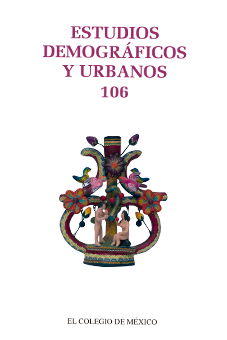El efecto del consumo de alcohol sobre el trabajo adolescente en México
Publicado 2020-11-13
Palabras clave
- trabajo,
- jóvenes,
- alcohol,
- México.
Cómo citar
-
Resumen3417
-
PDF (español)992
-
En línea (español)295
Descargas
Derechos de autor 2020 Estudios Demográficos y Urbanos

Esta obra está bajo una licencia internacional Creative Commons Atribución-NoComercial-SinDerivadas 4.0.
Métrica
Resumen
En México, uno de cada cuatro jóvenes de 12 a 17 años consume alcohol y se encuentra trabajando. El consumo de alcohol está asociado a una mayor probabilidad de trabajar a una edad temprana, y la situación laboral podría fomentar un mayor consumo de éste. Para controlar los sesgos por causalidad inversa y por selectividad, se utilizan como instrumentos la influencia de los pares y las emociones de los adolescentes. Los resultados indican una relación directa y robusta entre el consumo de alcohol y el trabajo de los adolescentes, de entre 2.07 y 2.34 puntos porcentuales.
Referencias
- Alcaraz, C., Chiquiar, D. y Salcedo, A. (2012). Remittances, schooling, and child labor in Mexico. Journal of Development Economics, 97(1), 156-165. Recuperado de https://www.sciencedirect.com/science/article/abs/pii/S0304387810001318?via%3Dihub DOI: https://doi.org/10.1016/j.jdeveco.2010.11.004
- Babor, T., Higgins-Biddle, J., Saunders, J. y Monteiro, M. (2001). Cuestionario de identificación de los trastornos debidos al consumo de alcohol. Ginebra: Organización Mundial de la Salud. Recuperado de https://www.who.int/substance_abuse/activities/en/AUDITmanualSpanish.pdf
- Basu, K. y Hoang Van, P. (1998). The economics of child labor. The American Economic Review, 88(3), 412-427. Recuperado de http://www.jstor.org/stable/116842
- Becker, G. y Murphy, K. (1988). A theory of rational addiction. Journal of Political Economy, 96(4), 675-700. Recuperado de https://www.journals.uchicago.edu/doi/10.1086/261558 DOI: https://doi.org/10.1086/261558
- Beegle, K., Dehejia, R. y Gatti, R. (2009). Why should we care about child labor? The education, labor market, and health consequences of child labor. Journal of Human Resources, 44(4), 871-889. Recuperado de http://jhr.uwpress.org/content/44/4/871.short DOI: https://doi.org/10.1353/jhr.2009.0025
- Berger, C., Milicic, N., Alcalay, L. y Torretti, A. (2014). Programa para el bienestar y aprendizaje socioemocional en estudiantes de tercero y cuarto grado: descripción y evaluación de impacto. Revista Latinoamericana de Psicología, 46(3), 169-177. Recuperado de https://www.sciencedirect.com/science/article/pii/S0120053414700202?via%3Dihub DOI: https://doi.org/10.1016/S0120-0534(14)70020-2
- Bound, J., Jaeger, D. y Baker, R. (1995). Problems with instrumental variables estimation when the correlation between the instruments and the endogenous explanatory variable is weak. Journal of the American Statistical Association, 90(430), 443-450. Recuperado de https://www.tandfonline.com/doi/abs/10.1080/01621459.1995.10476536 DOI: https://doi.org/10.1080/01621459.1995.10476536
- Cahuc, P. y Zylberberg, A. (2004). Labor economics, MIT Press.
- Cameron, A. y Trivedi, P. (2005). Microeconometrics: Methods and applications. Cambridge University Press. DOI: https://doi.org/10.1017/CBO9780511811241
- Conway, D. y Roberts, H. (1983). Reverse regression, fairness, and employment discrimination. Journal of Business and Economic Statistics, 1(1), 75-85. Recuperado de https://amstat.tandfonline.com/doi/abs/10.1080/07350015.1983.10509326#.XoVVNupKjIU DOI: https://doi.org/10.1080/07350015.1983.10509326
- De Janvry, A., Finan, F. y Sadoulet, E. (2004). Can conditional cash transfers serve as safety nets to keep children at school and out of the labor market? Berkeley: University of California, Department of Agricultural and Resource Economics. Recuperado de https://escholarship.org/uc/item/5fp0g5p2
- Edmonds, E. (2007). Child labor. (Documento de Trabajo, núm. 2626). Bonn, Alemania: IZA Institute of Labor Economics. Recuperado de http://nbn-resolving.de/urn:nbn:de:101:1-20080422146 DOI: https://doi.org/10.3386/w12926
- ENA. (2011). Encuesta Nacional de Adicciones 2011: reporte de drogas. Ciudad de México: Instituto Nacional de Psiquiatría Ramón de la Fuente Muñiz / Instituto Nacional de Salud Pública / Secretaría de Salud. Recuperado de http://www.conadic.salud.gob.mx/pdfs/ENA_2011_DROGAS_ILICITAS_.pdf
- Encodat. (2016). Encuesta Nacional de Consumo de Drogas, Alcohol y Tabaco 2016-2017: reporte de alcohol. Ciudad de México: Instituto Nacional de Psiquiatría Ramón de la Fuente Muñiz / Instituto Nacional de Salud Pública / Secretaría de Salud. Recuperado de https://www.insp.mx/avisos/4585-encodat-2016.html
- Espada Sánchez, J., Pereira, J. y García-Fernández, J. (2008). Influencia de los modelos sociales en el consumo de alcohol de los adolescentes. Psicothema, 20(4), 531-537. Recuperado de www.unioviedo.net/reunido/index.php/PST/article/download/8693/8557
- Forastieri, V. (2002). Children at work: Health and safety risks. International Labour Organization. Recuperado de https://www.ilo.org/global/topics/safety-and-health-at-work/resources-library/publications/WCMS_235332/lang--en/index.htm
- Grootaert, C. y Kanbur, R. (1994). Child labour: A review. (Documento de Trabajo, núm. 1454). The World Bank. Recuperado de http://gdsnet.org/Child-Labor-aReview.PDF
- Guarcello, L., Lyon, S. y Valdivia, C. (2016). Adolescents in hazardous work: Child labour among children aged 15-17 years. (Documento de Trabajo). Understanding Children’s Work (UCW). Recuperado de http://www.ucw-project.org/attachment/23052017377Hazardous_work_adolescents_in_CL_july2016.pdf
- Guzmán, F., Pedrão, L., Rodríguez, L., López, S. y Esparza, S. (2007). Trastornos por consumo de alcohol (AUDIT) en adolescentes y jóvenes marginales de bandas juveniles de México. Escola Anna Nery. Revista de Enfermagem, 11(4), 1-11. Recuperado de http://www.scielo.br/scielo.php?script=sci_arttext&pid=S1414-81452007000400009&lng=es&tlng=es DOI: https://doi.org/10.1590/S1414-81452007000400009
- Harris, M. y Fennell, M. (1988). A multivariate model of job stress and alcohol consumption. The Sociological Quarterly, 29(3), 391-406. Recuperado de http://www.jstor.org/stable/4121498 DOI: https://doi.org/10.1111/j.1533-8525.1988.tb01260.x
- Hawkins, D., Catalano, R. y Miller, Y. (1992). Risk and protective factors for alcohol and other drug problems in adolescence and early adulthood: Implications for substance abuse prevention. Psychological Bulletin, 112(1), 64-105. Recuperado de https://psycnet.apa.org/doiLanding?doi=10.1037%2F0033-2909.112.1.64 DOI: https://doi.org/10.1037/0033-2909.112.1.64
- Heady, C. (2003). The effect of child labor on learning achievement. World Development, 31(2), 385-398. Recuperado de https://www.sciencedirect.com/science/article/abs/pii/S0305750X02001869?via%3Dihub DOI: https://doi.org/10.1016/S0305-750X(02)00186-9
- Ilahi, N., Orazem, P. y Sedlacek, G. (2000). The implications of child labor for adult wages, income and poverty: Retrospective evidence from Brazil. The World Bank. Recuperado de https://www.researchgate.net/publication/247904326_The_Implications_of_Child_Labor_for_Adult_Wages_Income_and_Poverty_Retrospective_Evidence_from_Brazil
- International Labour Organization (ILO). (2013). Global child labour trends 2008 to 2012. International Labour Office, International Programme on the Elimination of Child Labour. Recuperado de https://www.ilo.org/ipec/informationresources/WCMS_IPEC_PUB_23015/lang--en/index.htm
- Kandel, D. y Yamaguchi, K. (1987). Job mobility and drug use: An event history analysis. American Journal of Sociology, 92(4), 836-878. Recuperado de https://www.journals.uchicago.edu/doi/10.1086/228585 DOI: https://doi.org/10.1086/228585
- Kassouf, A., McKee, M. y Mossialos, E. (2001). Early entrance to the job market and its effect on adult health: Evidence from Brazil. Health Policy and Planning, 16(1), 21-28. Recuperado de https://academic.oup.com/heapol/article/16/1/21/617048 DOI: https://doi.org/10.1093/heapol/16.1.21
- Keng, S. (1998). The demand for health, alcohol abuse, and labor market outcomes: A longitudinal study. Retrospective Theses and Dissertations, 11935. Iowa State University. Recuperado de https://lib.dr.iastate.edu/rtd/11935
- Keng, S. y Huffman, W. (2007). Binge drinking and labor market success: A longitudinal study on young people. Journal of Population Economics, 20(1), 35-54. Recuperado de https://ideas.repec.org/a/spr/jopoec/v20y2007i1p35-54.html
- Maddala, G. (2001). Introduction to econometrics. Chichester, Reino Unido: John Willey and Sons.
- Módulo de Trabajo Infantil (MTI). (2017). Principales resultados. Encuesta Nacional de Ocupación y Empleo. Cuarto trimestre. Instituto Nacional de Estadística y Geografía, INEGI. Recuperado de https://www.inegi.org.mx/contenidos/programas/mti/2017/doc/mti2017_resultados.pdf
- Mullahy, J. y Sindelar, J. (1993). Alcoholism, work, and income. Journal of Labor Economics, 11(3), 494-520. Recuperado de https://www.journals.uchicago.edu/doi/10.1086/298305 DOI: https://doi.org/10.1086/298305
- Murray, M. (2006). Avoiding invalid instruments and coping with weak instruments. Journal of Economic Perspectives, 20(4), 111-132. Recuperado de https://www.aeaweb.org/articles?id=10.1257/jep.20.4.111 DOI: https://doi.org/10.1257/jep.20.4.111
- OECD. (2015). Tackling harmful alcohol use economics and public health policy: Economics and public health policy. OECD Publishing. Recuperado de https://www.oecd.org/health/tackling-harmful-alcohol-use-9789264181069-en.htm
- Pavis, S., Cunningham-Burley, S. y Amos, A. (1997). Alcohol consumption and young people: Exploring meaning and social context. Health Education Research, 12(3), 311-322. Recuperado de https://academic.oup.com/her/article/12/3/311/683115 DOI: https://doi.org/10.1093/her/12.3.311
- Peirce, R., Frone, M., Russell, M. y Cooper, M. (1994). Relationship of financial strain and psychosocial resources to alcohol use and abuse: The mediating role of negative affect and drinking motives. Journal of Health and Social Behavior, 35(4), 291-308. Recuperado de http://www.jstor.org/stable/2137211 DOI: https://doi.org/10.2307/2137211
- Psacharopoulos, G. (1997). Child labor versus educational attainment some evidence from Latin America. Journal of Population Economics, 10(4), 377-386. Recuperado de https://link.springer.com/article/10.1007%2Fs001480050049 DOI: https://doi.org/10.1007/s001480050049
- Ranzani, M. y Rosati, F. (2014). Revisiting the impact of Oportunidades on children’s activity in Mexico. (Documento de Trabajo). Understanding Children’s Work (UCW). Recuperado de http://www.ucw-project.org/attachment/UCW_Oportunidades_impact_child_activity20150219_154855.pdf
- Ray, R. (2002). The determinants of child labour and child schooling in Ghana. Journal of African Economies, 11(4), 561-590. Recuperado de https://academic.oup.com/jae/article-abstract/11/4/561/750238?redirectedFrom=fulltext DOI: https://doi.org/10.1093/jae/11.4.561
- Reinert, F. y Allen, J. (2002). The alcohol use disorders identification test (AUDIT): A review of recent research. Alcoholism: Clinical and Experimental Research, 26(2), 272-279. Recuperado de https://onlinelibrary.wiley.com/doi/abs/10.1111/j.1530-0277.2002.tb02534.x DOI: https://doi.org/10.1111/j.1530-0277.2002.tb02534.x
- Salamó, A., Gras Pérez, M. y Font-Mayolas, S. (2010). Patrones de consumo de alcohol en la adolescencia. Psicothema, 22(2), 189-295. Recuperado de http://www.psicothema.com/psicothema.asp?id=3714
- San José, B., van de Mheen, H., van Oers, J., Mackenbach, J. y Garretsen, H. (2000). Adverse working conditions and alcohol use in men and women. Alcoholism: Clinical and Experimental Research, 24(8), 1207-1213. Recuperado de https://onlinelibrary.wiley.com/doi/abs/10.1111/j.1530-0277.2000.tb02085.x DOI: https://doi.org/10.1111/j.1530-0277.2000.tb02085.x
- Sargan, J. (1958). The estimation of economic relationships using instrumental variables. Econometrica. Journal of the Econometric Society, 26(3), 393-415. Recuperado de https://www.jstor.org/stable/1907619 DOI: https://doi.org/10.2307/1907619
- Schultz, T. (2004). School subsidies for the poor: Evaluating the Mexican Progresa poverty program. Journal of Development Economics, 74(1), 199-250. Recuperado de https://www.sciencedirect.com/science/article/abs/pii/S0304387803001858?via%3Dihub DOI: https://doi.org/10.1016/j.jdeveco.2003.12.009
- Selvanathan, E. (1991). Cross-country alcohol consumption comparison: An application of the Rotterdam demand system. Journal Applied Economics, 23(10), 1613-1622. Recuperado de https://www.tandfonline.com/doi/abs/10.1080/00036849100000126 DOI: https://doi.org/10.1080/00036849100000126
- Selvanathan, E. y Selvanathan, S. (2004). Economic and demographic factors in Australian alcohol demand. Journal Applied Economics, 36(21), 2405-2417. Recuperado de https://www.tandfonline.com/doi/abs/10.1080/0003684042000280346 DOI: https://doi.org/10.1080/0003684042000280346
- Skoufias, E., Parker, S., Behrman, J. y Pessino, C. (2001). Conditional cash transfers and their impact on child work and schooling: Evidence from the Progresa program in Mexico. Economía, 2(1), 45-96. Recuperado de https://www.jstor.org/stable/20065413 DOI: https://doi.org/10.1353/eco.2001.0016
- Staiger, D. y Stock, J. (1997). Instrumental variables regressions with weak instruments. (Documento de Trabajo, núm. 151). Massachusetts: National Bureau of Economic Research. Recuperado de https://www.nber.org/papers/t0151 DOI: https://doi.org/10.2307/2171753
- Telumbre-Terrero, J. y Sánchez-Jaimes, B. (2015). Consumo de alcohol en adolescentes del estado de Guerrero, México. Health and Addictions, 15(1), 79-86. Recuperado de https://ojs.haaj.org/index.php/haaj/article/view/217 DOI: https://doi.org/10.21134/haaj.v15i1.217
- Understanding Children’s Work (UCW). (2012). La experiencia mexicana en la reducción del trabajo infantil: evidencia empírica y lecciones políticas. Roma, Italia: Programa Entendiendo el Trabajo Infantil. Recuperado de http://www.ucw-project.org/
- Wooldridge, J. (2015). Introductory econometrics: A modern approach. Nelson Education. Recuperado de https://economics.ut.ac.ir/documents/3030266/14100645/Jeffrey_M._Wooldridge_Introductory_Econometrics_A_Modern_Approach__2012.pdf



